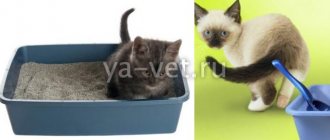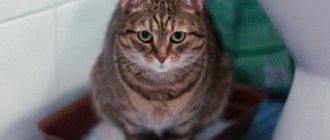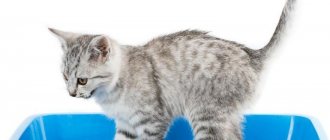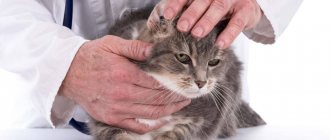Why can't the cat go to bed?
Urinary disorders in cats are a collection of clinical manifestations. A clear symptom is that the animal cannot make a full puddle. But this is expressed in different ways: the pet does not walk at all or, on the contrary, constantly runs into the tray, squeezing out drops a little. At the same time, the poor fellow suffers from pain in the abdomen and/or perineum, the body temperature rises sharply, vomiting, weakness, clouding of consciousness, etc. occur. What kind of manifestations will arise in a particular situation depends on the disease that caused urinary retention.
Urinary retention in a cat can take one of four forms:
- Obstruction (obstruction) of the ureter due to blockage of its mouth, for example, by stones in urolithiasis.
- Compression of the urethra from the outside by inflamed and edematous tissues of neighboring organs, benign and malignant neoplasms.
- Spasm of the muscles of the urethra and/or bladder due to the fact that the brain and spinal cord no longer regulate contractile function normally. For example, this happens after a stroke, injury, spinal hernia, etc.
- Anuria is the cessation of urine flow from the upper urinary tract into the bladder (more often occurs with kidney disease).
Sometimes a cat provokes urinary retention on purpose. This may be due to fear of going into the litter box (for example, when a cat who has given birth is afraid to leave her newborn kittens). Also, a cat may refuse to go to the toilet due to pain that accompanies the act of urination (for example, due to urethral injuries or genital infections).
A cat may not go to the litter box because of an unpleasant smell or uncomfortable conditions (when he is constantly distracted from “important matters”) - in such a situation, the animal will either pee in unauthorized places or completely restrain himself from going to the toilet, which will lead to to diseases of the genitourinary system
Pathologies that cause urinary retention can be congenital, for example, if a kitten was born with an excessively narrow and curved urethra. But more often the disorders are acquired. The reasons are:
- poor nutrition and lack of water. Excess protein, salt, oxalic and uric acid in combination with low fluid intake leads to urolithiasis.
- sedentary lifestyle and obesity.
- complications after surgery on the pelvic organs.
- hormonal disorders leading to a slowdown in metabolism.
- drug and chemical intoxication, for example, poisoning with non-narcotic analgesics.
If the cat has not visited the litter box for a long time, then it is necessary to exclude dehydration: refusal to drink may be associated with contamination of the water or dishes, conflicts over bowls with other pets
Often, urinary retention is the result of an illness that is not detected in time and not completely cured. In males, acute urinary retention is caused by complicated prostatitis and prostatic hyperplasia. In females - uterine prolapse or ectopic pregnancy. The cause is diseases of the genitourinary system (infections, cystitis, etc.). Even a common cold can be “fertile ground” for chronic inflammation of the urinary system and further problems with urination.
Damage to the kidney tissue is very dangerous, leading to kidney failure. They cause anuria - urine does not reach the bladder. The root cause may be:
- hypothermia;
- acute poisoning;
- cardiogenic or traumatic shock;
- embolism (blockage with blood clots) and thrombosis of renal vessels;
- heart failure, when renal circulation is disrupted and organ tissues die.
Who's at risk
Cats suffer from diseases associated with urinary retention more often than cats. This is due to the structure of the urethra. In males it is narrower than in females and has a bend. Because of this, its mouth is more quickly compressed, and salt crystals are not removed during urination, but “get stuck.”
Cats picked up from the street often suffer from urinary disorders due to untreated diseases caused by poor nutrition, poor water, and hypothermia.
Spayed and neutered animals are at particular risk. After surgery, their hormonal levels change, increasing the risk of developing hormone-dependent cancer. In addition, metabolism slows down, a tendency to obesity appears, and these are factors for the development of urolithiasis.
There is also a genetic predisposition to problems with the urinary system. The most susceptible to them are representatives of such breeds as Russian Blue, Siamese, Burmese, Carthusian, and Maine Coon. But the sad leader in the number of cases of acute urinary retention is occupied by Persian cats and their mestizos.
Prevention
After a urine blockage, lifestyle changes may be necessary to prevent a recurrence of this life-threatening condition. Several factors have been identified as potential contributors to urethral blockage, including family stress and inadequate access to or consumption of water, poor quality feed, sedentary lifestyle, hard water, and fish feeding.
Below are steps your veterinarian may recommend to prevent future recurrences:
- Increase the amount of water your cat drinks. This “simple” strategy is strongly associated with reducing recurrent urinary blockage. Talk to your veterinarian about creative ways to get your cat to drink more water.
- Reviewing your pet's diet and feeding rations
- Your veterinarian may recommend a modified diet or prescribe a prescription therapeutic diet—perhaps one that can help dissolve certain types of crystals or stones
- Improving your pet's living conditions means enriching the environment. Making sure your cat feels safe and encouraging her to be active and in a good mood is an important way to help reduce or eliminate stress in the home. Improving housing conditions often includes proper control of litter tray cleanliness, as well as access to climbing structures, resting areas and scratching areas. Synthetic cat pheromones may help reduce stress and anxiety in some cats
How to tell if your cat has urinary problems
There are several types of urinary retention:
- Chronic delay. When visiting the litter box, urine is released, but not completely; the feeling of a full bladder still remains, which encourages the animal to constantly run to the toilet. This picture lasts for a couple of hours or several days, then the condition returns to normal for a while. The periods of improvement will be shorter the more advanced the disease.
- Acute urinary retention, when the cat’s condition suddenly deteriorates with a complete cessation of urination. The symptoms are increasing, that is, the animal is getting worse and worse. Without immediate medical attention, it will die.
The acute phase can be recognized by very characteristic signs. In addition to the complete absence of emptying the bladder, the cat experiences weakness, periodic vomiting, increased body temperature, and a strong ammonia odor from the mouth. A characteristic symptom is the “ball” - severe swelling of the lower abdomen. It becomes round, hard to the touch, and painful. Not letting the situation reach such a critical state is the task of all pet owners. To do this, you need to pay attention to the signs of early development of pathology:
- the cat’s posture when urinating is tense, which indicates an effort and pain in the process;
- the animal constantly licks the groin and abdomen area, which indicates pain;
- the cat behaves anxiously, hides, does not make contact with people, meows pitifully, refuses water and food.
A tense posture when emptying the bladder indicates that the animal is straining and experiencing pain.
Owners need to watch not only the cat’s behavior, but also what its waste products look like. An alarming sign is the presence of sand, pus, and blood in the urine. Unfortunately, due to the use of filler, it is difficult to discern foreign impurities. It is recommended that the tray be left empty periodically to allow for evaluation. Better yet, collect urine with a pipette 1-2 times a year and take it to the veterinary clinic for biochemical analysis.
Diagnostic methods
Without an accurate diagnosis, starting treatment is prohibited. It is important to conduct a full examination of the cat in a clinical setting before drawing up a treatment plan. Remember that even a veterinarian will not be able to reliably find out the pathology, its form and degree of development at home. Clinical examination, laboratory, ultrasound, X-ray examinations are required:
- The sound is determined by lightly tapping the abdomen (percussion) - normally it should be ringing. Palpation allows you to feel a full bladder.
- An x-ray and ultrasound reveal a dark formation of considerable size - this is a full bladder. If we are talking about anuria, then it will be empty, but greatly enlarged kidneys with signs of necrosis will be found.
- A computed tomogram is used in addition to ultrasound for a more detailed study of stones, tumors, and hyperplasia that lead to compression of the urinary tract.
- Urine examination (in case of acute retention, it is taken through catheterization) is necessary to identify infection, pus, blood impurities, as well as determine the type of stones in urolithiasis.
- A blood test is needed to assess the general condition of the cat, the presence of an inflammatory or intoxication process.
After a long (more than a day) delay in urination, it is better to leave cats for several days in the clinic’s hospital, so that if the exacerbation recurs, an emergency ultrasound can be performed, a catheter placed, or an IV with the necessary medications installed.
Idiopathic cystitis
If, based on the results of a complete examination, the cause of the development of cystitis is not established, the doctor may make a diagnosis of “idiopathic cystitis,” i.e. “having no apparent identifiable cause.” However, this disease is an independent entity in cats and is quite widespread in the population.
Stress can provoke the development of idiopathic cystitis in cats. It is believed that the predisposition to idiopathic cystitis is congenital, and is associated both with defects in the mucous membrane of the bladder and with increased production of “stress hormones” - catecholamines and cortisol.
How to help a cat who hasn't walked for a long time
If the cat has not gone to the litter box for a long time, then you do not need to massage his stomach yourself, give him diuretics or drugs that help break down stones. In some cases, these measures are contraindicated and can only provoke rupture of the urethra or bladder, leading to death. The necessary measures must be determined by a veterinarian.
First of all, it is necessary to remove accumulated urine from the body. If the cause is a spasm of the urethra, then the animal is given an injection of an antispasmodic. In case of urolithiasis, catheterization is performed: a thin tube is carefully inserted into the urethra, then a warm sodium chloride solution is poured in, which gradually removes the stone that has blocked the mouth. This ensures the outflow of stagnant urine. If the stone is too large or the cause of the blockage is compression of the urethra by enlarged inflamed tissues or a tumor, then it will not be possible to install a catheter, an operation is performed:
- urethrostomy - the surgeon creates a new opening in the urethra and installs an indwelling urethral Foley catheter;
- epicystostomy - a hole is made in the bladder, a drainage is inserted into it, through which urine will flow out.
If the urethra is severely damaged (severe blockage, narrowing of the canal, large-scale tumor, etc.), amputation of the cat’s penis is recommended. This radical measure is carried out when other methods cannot ensure the rapid and unimpeded passage of urine, sand, and stones.
Clinical example No. 1: a 9-year-old Persian cat was admitted. 3 weeks ago, the owners of the animal began to notice an increase in the duration of urination. The last 2 days - urination stopped completely, there was a general depressed state and refusal of food and water. Catheterization failed due to a palpable obstruction in the urethra. Ultrasound revealed adenocarcinoma of the prostate gland compressing the urinary duct. The animal underwent retrograde cystography under fluoroscopic control. Within 24 hours, the patient’s condition stabilized, but after 24 hours hematuria (excretion of urine with blood) appeared. Catheterization was performed with saline solution. After stabilizing the animal's condition, urethral stenting and removal of the tumor were prescribed.
Depending on the diagnosis, medications are added to the emergency program. For example, for tissue hyperplasia, alpha-blockers and cholinomimetics (Ubretide, Aceclidine, etc.) are given. If urinary retention is caused by urosepsis, acute pyelitis, pyelonephritis, then an operation is performed to remove dead tissue, pump out pus, restore blood flow, normalize pressure, etc.
If the cause of urinary retention is in tumors, then after excretion of urine using urethrostomy or epicystostomy, the surgeon excises the tumor compressing the urinary tract
Clinical example No. 2: Musick is a mongrel, 7 years old, neutered, weight 6 kg. The owners said that the animal had not urinated for 24 hours, was lethargic and refused food. The owners also noted that for 5–6 days the cat behaved restlessly, licked itself frequently, and there were drops of blood in the urine. An x-ray showed a full bladder. An ultrasound revealed multiple stones, which made it possible to make a diagnosis of urolithiasis. Emergency catheterization under general anesthesia, lavage of the bladder with a sterile isotonic sodium chloride solution, and a drip with the antibiotic Cefazolin were prescribed. The cat was discharged from the clinic on the 3rd day. It was recommended to transfer the cat to dietary medicinal food aimed at dissolving struvite stones (duration of dietary therapy is 6 months).
After removing the cat from the emergency condition, measures are taken to eliminate the cause of the pathology. Therapy may include taking antibiotics, anti-inflammatory drugs, antispasmodics, etc. For urolithiasis, medications are given that break down and remove stones. In each case, medications are selected individually, taking into account the composition of the stones, gender, and age of the animal. A diet is required, as improper nutrition can again cause acute urinary retention. For example, special foods have been developed for cats with urolithiasis that help reduce the risk of new exacerbations (Hill's Prescription Diet, Pro Plan Veterinary Diets Feline UR Urinary, etc.).











